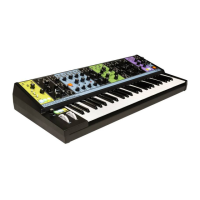15
2 3 SYNC
Pressing this button (On/lit red) will cause Oscillator 3 to become sync’d to
Oscillator 2. In this case, changing the Frequency of Oscillator 3 will vary the
degree of the Sync effect and its associated harmonic content. The range of
the FREQUENCY knob is also greatly increased while the oscillator is sync’d.
3 4 SYNC
Pressing this button (On/lit red) will cause Oscillator 4 to become sync’d to
Oscillator 3. In this case, changing the Frequency of Oscillator 4 will vary the
degree of the Sync effect and its associated harmonic content. The range of
the FREQUENCY knob is also greatly increased while the oscillator is sync’d.
NOTE: Remember, the main red SYNC button must be On (lit) for the individual
Oscillator Sync functions to work.
WAVEFORM (Triangle, Sawtooth, Square, Pulse)
Each waveform has unique harmonic content that is based on the number and
strength of the harmonic overtones that it contains. These overtones are what
impart a particular timbre, or character, to the sound of each oscillator. This
four-position knob is used to select the oscillator’s waveform. The choices are
Triangle, Sawtooth, Square, and Narrow Pulse.
TRIANGLE
The Triangle wave has an extremely strong fundamental, and contains only
odd-numbered harmonics at very low levels. This makes the Triangle wave an
ideal choice for creating soft, flute-like sounds that have a relatively pure tone
with little overtone activity.
TIP: Try mixing a Triangle wave from one oscillator with a more complex wave from
another to emphasize one particular harmonic without adding unwanted overtones.
SAWTOOTH
The Sawtooth wave is the most harmonically dense of the four waveform
options, containing all of the natural harmonics in relatively strong levels.
In addition to creating thick, brassy sounds, the Sawtooth wave lends itself
to powerful lead and bass sounds as well.
PULSE WAVES (Square & Narrow Pulse)
A Pulse wave contains only odd-numbered harmonics. Think of it as a switch that is being turned off
and on hundreds or thousands of times per second. Pulse width, or duty cycle, is the percentage of
time that the wave is “on.” Every pulse width has its own unique harmonic structure, making a variety
of basic timbres possible.
OSCILLATORS (Continued)

